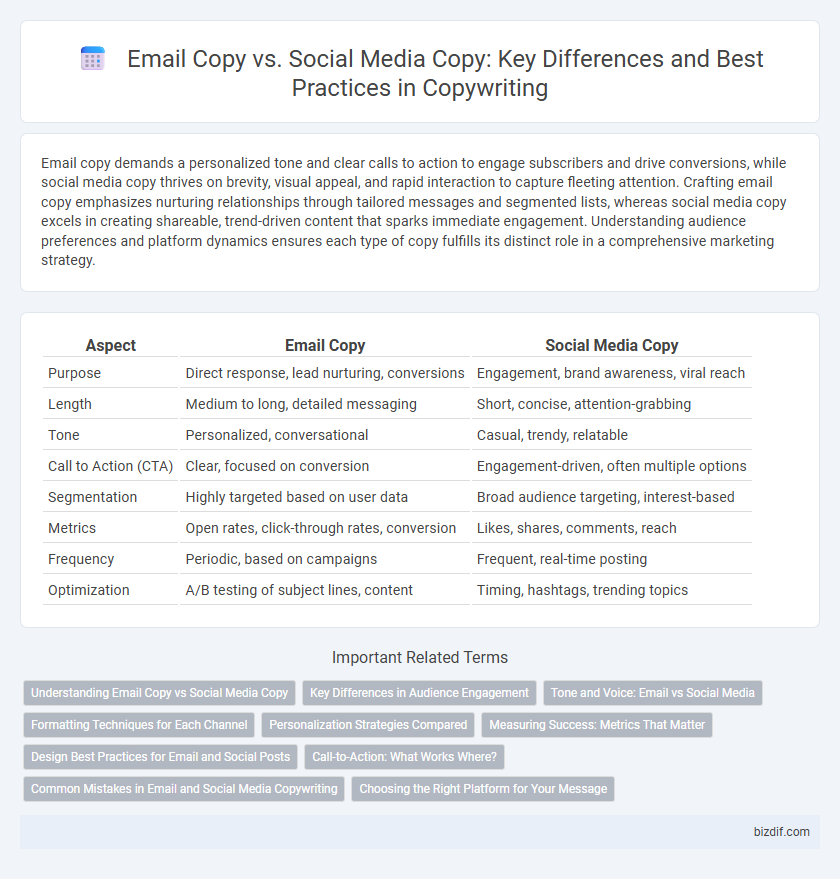Email copy demands a personalized tone and clear calls to action to engage subscribers and drive conversions, while social media copy thrives on brevity, visual appeal, and rapid interaction to capture fleeting attention. Crafting email copy emphasizes nurturing relationships through tailored messages and segmented lists, whereas social media copy excels in creating shareable, trend-driven content that sparks immediate engagement. Understanding audience preferences and platform dynamics ensures each type of copy fulfills its distinct role in a comprehensive marketing strategy.
Table of Comparison
| Aspect | Email Copy | Social Media Copy |
|---|---|---|
| Purpose | Direct response, lead nurturing, conversions | Engagement, brand awareness, viral reach |
| Length | Medium to long, detailed messaging | Short, concise, attention-grabbing |
| Tone | Personalized, conversational | Casual, trendy, relatable |
| Call to Action (CTA) | Clear, focused on conversion | Engagement-driven, often multiple options |
| Segmentation | Highly targeted based on user data | Broad audience targeting, interest-based |
| Metrics | Open rates, click-through rates, conversion | Likes, shares, comments, reach |
| Frequency | Periodic, based on campaigns | Frequent, real-time posting |
| Optimization | A/B testing of subject lines, content | Timing, hashtags, trending topics |
Understanding Email Copy vs Social Media Copy
Email copy requires personalized, direct messaging designed to foster deeper engagement and conversions through targeted subject lines and clear calls-to-action. Social media copy emphasizes concise, visually appealing content that encourages rapid interaction and sharing across platforms like Facebook, Instagram, and Twitter. Understanding the distinct audience behaviors and platform algorithms is essential for optimizing copy effectiveness in email marketing versus social media campaigns.
Key Differences in Audience Engagement
Email copy targets a highly engaged, permission-based audience, allowing for personalized messaging and direct calls to action that drive conversions. Social media copy reaches a broader, more diverse audience, encouraging interaction through likes, shares, and comments that increase brand visibility. The key difference lies in email's focus on relationship-building and targeted offers, while social media emphasizes real-time engagement and community growth.
Tone and Voice: Email vs Social Media
Email copy typically employs a personalized, direct tone that builds trust and encourages action through tailored messaging and a conversational voice. Social media copy often adopts a casual, engaging tone designed to capture attention quickly and foster interaction within a broader audience. Brands must adapt their voice accordingly to maintain consistency while optimizing engagement across both email campaigns and social platforms.
Formatting Techniques for Each Channel
Email copy utilizes personalized subject lines, concise paragraphs, and clear CTAs to enhance readability and engagement, leveraging white space and bullet points for scannability. Social media copy relies on concise text, strategic hashtag use, emojis, and varied formatting such as line breaks or caps lock to capture attention in fast-scrolling feeds. Both channels benefit from A/B testing different formats to optimize user interaction and conversion rates.
Personalization Strategies Compared
Email copy leverages advanced personalization strategies by using recipient data such as names, purchase history, and browsing behavior to create tailored messages that boost engagement and conversion rates. Social media copy personalizes content through audience segmentation, platform-specific language, and interactive elements like polls and comments to drive real-time interaction and brand loyalty. Both copywriting approaches prioritize relevance, but email copy excels in deep personalization while social media copy focuses on dynamic, community-driven content.
Measuring Success: Metrics That Matter
Email copy success is primarily measured by open rates, click-through rates, and conversion rates, which directly indicate engagement and revenue generation. Social media copy relies on metrics like likes, shares, comments, and follower growth to assess brand awareness and audience interaction. Analyzing these platform-specific metrics enables marketers to optimize content strategy and maximize ROI efficiently.
Design Best Practices for Email and Social Posts
Email copy design prioritizes clear hierarchy, mobile responsiveness, and concise calls-to-action to maximize click-through rates and readability across devices. Social media copy demands visually engaging elements, short impactful text, and consistent branding to capture fast-scrolling audiences while encouraging interaction. Employing personalized content and adaptive layouts in emails, alongside vibrant images and platform-specific formats in social posts, drives higher engagement and conversion outcomes.
Call-to-Action: What Works Where?
Email copy often benefits from direct, personalized Call-to-Actions (CTAs) like "Download Now" or "Claim Your Offer," optimizing click-through rates through targeted messaging and clear value propositions. Social media copy requires concise, engaging CTAs such as "Join the Conversation" or "Share Your Thoughts" to foster interaction and viral sharing within fast-scrolling feeds. Understanding platform-specific user behavior enhances CTA effectiveness, driving conversions in email while boosting engagement on social channels.
Common Mistakes in Email and Social Media Copywriting
Common mistakes in email copywriting include generic subject lines that fail to engage, overly lengthy content that reduces readability, and lack of clear calls to action, which lead to low conversion rates. Social media copy often suffers from inconsistent brand voice, neglecting audience targeting, and overuse of hashtags that diminish message clarity. Both platforms require precise, tailored messaging to maximize audience engagement and drive results effectively.
Choosing the Right Platform for Your Message
Email copy excels in delivering personalized, targeted messages with higher conversion rates due to direct access to subscribers' inboxes. Social media copy thrives on engagement and brand awareness, leveraging real-time interaction and sharing across vast audiences. Selecting the right platform depends on campaign goals: use email for detailed, action-driven content and social media for broad reach and community building.
Email Copy vs Social Media Copy Infographic

 bizdif.com
bizdif.com